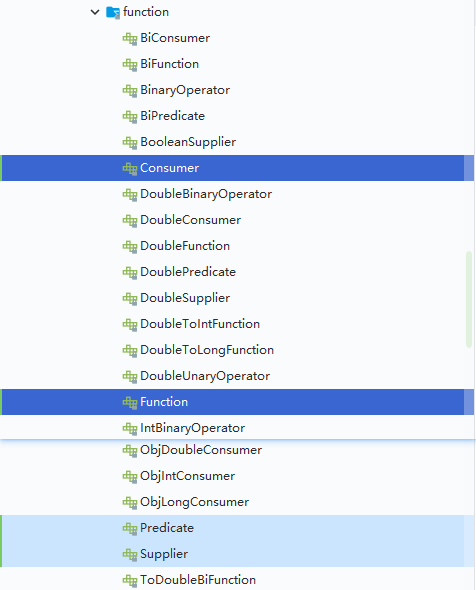Java 8 中需要知道的4個函數式介面-Function、Consumer、Supplier、Predicate
前言
Java 8 中提供了許多函數式介面,包括Function、Consumer、Supplier、Predicate 等等。這 4 個介面就是本篇將要分享的內容,它們都位於 java.util.function 包下。

為什麼需要知道這幾個函數式介面?
因為這 4 個函數式介面是 Java 8 中新增的重要介面,同時 Java 8 的 Stream 新特性,也有用到這些介面,所以學習它們可以幫助我們更好地理解 Stream 流。
也正因為這是函數式介面,所以就可以使用 Lambda 表示式來寫介面的實現邏輯。而且學習的過程中可以更好地理解函數語言程式設計的思想。
Function 介面
說明
Function 這個單詞的意思就有「函數」的意思,就數學中的 y = f(x),接收一個 x 引數,通過函數 f 運算後,返回一個結果 y。
Function 介面包含四個方法:
apply(T t):這是Function介面的主要方法,它接收一個引數並返回一個結果。同時它也是唯一的抽象的方法,剩下的都是有預設實現的(Java 8 中介面的抽象方法支援預設實現)。andThen(Function after):作用是將兩個Function組合。首先執行當前函數,再執行andThen函數,並將當前函數的結果作為引數傳遞給andThen函數。compose(Function before):同理,將兩個Function組合,將先執行compose函數,再執行當前函數,並將compose函數的結果作為引數傳遞給當前函數。identity(): 返回一個執行恆等轉換的函數,即返回輸入引數本身。
Function 介面通常用於將一個型別的值轉換為另一個型別的值。
apply 方法
// Function 介面的泛型,第一個引數是入參型別,第二個引數是出參型別
// Function 介面只有一個抽象方法,就是 apply(),下面利用 Lambda 表示式實現這個抽象方法並建立 Function 物件
Function<Integer, String> function = num -> "GTA" + num;
// 將5這個引數傳遞給function,得到返回結果
String result = function.apply(5);
System.out.println(result); // 列印:GTA5
andThen 和 compose 方法
// 定義兩個 Function 物件進行相關轉換操作
Function<String, String> upperCase = s -> s.toUpperCase();
Function<String, String> addPostfix = s -> s + "5";
// 鏈式呼叫,將 gta 這個字串引數先傳遞 upperCase 這個函數進行操作,然後將得到的結果傳遞給 addPostfix 函數進行操作,得到返回結果
String str = upperCase.andThen(addPostfix).apply("gta");
System.out.println(str); // 列印:GTA5
identify 方法
identity 方法返回一個執行恆等轉換的函數,該函數將輸入引數原樣返回。例如:
Function<String, String> identity = Function.identity();
String result = identity.apply("hello"); // result is "hello"
Consumer 介面
說明
Consumer 這個單詞的意思就有「消費者」的意思,就把入參消費了,並不會返回結果給你。
Consumer 介面包含兩個方法:
accept(T t):該方法接受一個引數並執行一些操作。andThen(Consumer after):同理,將兩個 Consumer 組合,先後進行消費。
accept 方法
Consumer 介面通常用於消費一個引數然後執行一些操作。例如:
// Consumer 介面,泛型引數是入參型別,接受一個引數,並不返回結果,相當於消費了這個引數
Consumer<String> consumer = s -> System.out.println(s);
consumer.accept("我輸入什麼就列印什麼"); // 列印:我輸入什麼就列印什麼
andThen 方法
組合兩個 Consumer:
Consumer<String> first = s -> System.out.println(s + 5);
Consumer<String> second = s -> System.out.println(s + 6);
// 先執行 first 這個 Consumer,接著執行 second 這個 Consumer
Consumer<String> combination = first.andThen(second);
combination.accept("GTA"); // 列印:GTA5 GTA6
Supplier 介面
Supplier 介面只定義了一個 get() 方法,該方法不接受任何引數並返回一個結果。
Supplier 這個單詞的意思就有「供應者」的意思,給我的感覺就是生產者,不用引數,直接生產一個東西給你。
Supplier 介面通常用於生成一個值。例如:
// Supplier 介面,泛型引數是出參型別,不接受引數,但是會提供結果,相當於生產了某個東西
Supplier<String> supplier = () -> "提供一個我隨便打的字串給呼叫方";
String text = supplier.get();
System.out.println(text); // 列印:提供一個我隨便打的字串給呼叫方
Predicate 介面
說明
Predicate 這個單詞的意思就有「預言,預測,謂語,謂詞」的意思,就是用來預測判斷的。
Predicate 介面包含四個方法:
test(T t):該方法接受一個引數並返回一個布林值。and(Predicate other):與另一個 Predicate 進行組合,實現邏輯與操作。negate():與另一個 Predicate 進行組合,實現邏輯非操作。or(Predicate other):與另一個 Predicate 進行組合,實現邏輯或操作。
test 方法
Predicate 介面通常用於測試一個條件是否成立。例如:
// Predicate 介面,泛型引數是入參型別,返回布林值
Predicate<String> predicate = s -> s.contains("god23bin");
boolean flag = predicate.test("god23bin能給你帶來收穫嗎?");
System.out.println("god23bin能給你帶來收穫嗎?" + flag); // 列印:god23bin能給你帶來收穫嗎?true
and 方法
為了便於演示,這裡準備兩個 Predicate:
Predicate<String> startsWithA = (str) -> str.startsWith("A"); // 如果傳入的字串是A開頭,則返回 true
Predicate<String> endsWithZ = (str) -> str.endsWith("Z"); // 如果傳入的字串是Z結尾,則返回 true
使用 and 進行組合,與操作:
Predicate<String> startsWithAAndEndsWithZ = startsWithA.and(endsWithZ);
System.out.println(startsWithAAndEndsWithZ.test("ABCDEFZ")); // true
System.out.println(startsWithAAndEndsWithZ.test("BCDEFGH")); // false
negate 方法
使用 negate 進行組合,非操作:
Predicate<String> notStartsWithA = startsWithA.negate();
System.out.println(notStartsWithA.test("ABCDEF")); // false
System.out.println(notStartsWithA.test("BCDEFGH")); // true
or 方法
使用 or 進行組合,或操作:
Predicate<String> startsWithAOrEndsWithZ = startsWithA.or(endsWithZ);
System.out.println(startsWithAOrEndsWithZ.test("ABCDEF")); // true
System.out.println(startsWithAOrEndsWithZ.test("BCDEFGH")); // false
那這些介面有什麼應用呢?
在 Stream 流中就有應用上這些函數式介面。當然,當你有相似的需求時,你自己也可以應用上這些介面。下面說下 Stream 流中的應用。
Function 介面:例如 map 方法,map 方法就是將一個型別的值轉換為另一個型別的值。
// map 方法,將 T 型別的值轉換成 R 型別的值
// R 是返回的 Stream 流的元素型別,T 是原先 Stream 流的元素型別
<R> Stream<R> map(Function<? super T, ? extends R> mapper);
Consumer 介面:例如 forEach 方法
// forEach 方法,遍歷 Stream 流中的元素,T 型別是 Stream 流的元素型別
void forEach(Consumer<? super T> action);
Supplier 介面:例如 generate 方法
// 生成一個無限長度的 Stream 流
public static<T> Stream<T> generate(Supplier<T> s) {
Objects.requireNonNull(s);
return StreamSupport.stream(
new StreamSpliterators.InfiniteSupplyingSpliterator.OfRef<>(Long.MAX_VALUE, s), false);
}
Predicate 介面:例如 filter 方法,使用 Predicate 進行過濾操作。
// 過濾出 Stream 流中,判斷結果為 true 的元素
Stream<T> filter(Predicate<? super T> predicate);
最後的最後
希望各位螢幕前的靚仔靚女們給個三連!你輕輕地點了個贊,那將在我的心裡世界增添一顆明亮而耀眼的星!
咱們下期再見!